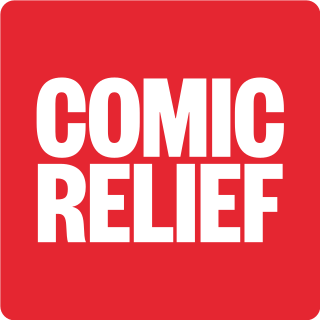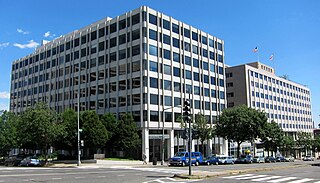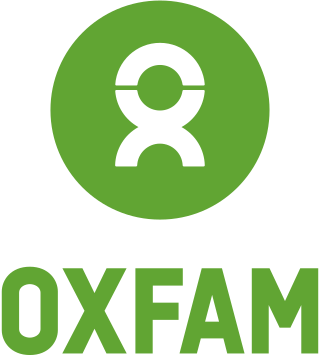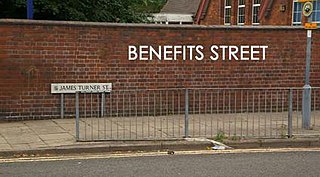
A stock character, also known as a character archetype, is a type of character in a narrative whom audiences recognize across many narratives or as part of a storytelling tradition or convention. There is a wide range of stock characters, covering people of various ages, social classes and demeanors. They are archetypal characters distinguished by their simplification and flatness. As a result, they tend to be easy targets for parody and to be criticized as clichés. The presence of a particular array of stock characters is a key component of many genres, and they often help to identify a genre or subgenre. For example, a story with the stock characters of a knight-errant and a witch is probably a fairy tale or fantasy.

Comic Relief is a British charity, founded in 1985 by the comedy scriptwriter Richard Curtis and comedian Sir Lenny Henry in response to the famine in Ethiopia. The concept of Comic Relief was to get British comedians to make the public laugh, while raising money to help people around the world and in the United Kingdom. A new CEO, Samir Patel, was announced in January 2021.

Welfare, or commonly social welfare, is a type of government support intended to ensure that members of a society can meet basic human needs such as food and shelter. Social security may either be synonymous with welfare, or refer specifically to social insurance programs which provide support only to those who have previously contributed, as opposed to social assistance programs which provide support on the basis of need alone. The International Labour Organization defines social security as covering support for those in old age, support for the maintenance of children, medical treatment, parental and sick leave, unemployment and disability benefits, and support for sufferers of occupational injury.

A charitable organization or charity is an organization whose primary objectives are philanthropy and social well-being.
Trócaire is the official overseas development agency of the Catholic Church in Ireland.

Vivian Chow Wai-man is a Hong Kong-based Cantopop singer-songwriter and actress.

A benefit concert or charity concert is a type of musical benefit performance featuring musicians, comedians, or other performers that is held for a charitable purpose, often directed at a specific and immediate humanitarian crisis.

The practice of charity, which is the voluntary provision of assistance to those in need, serves as a humanitarian act, and is unmotivated by self-interest. Various philosophies about charity exist, with frequent associations with religion.
Famine events are localized events of voluntary fasting for 30 or 40 hours depending on the region to raise money and awareness for world hunger. These events are usually coordinated by one of various World Vision organizations and are done by youth in church organizations. They have spread internationally, notably the international 30 Hour Famine, also the regional 40 Hour Famine in Australia and New Zealand and the 24 Hour Famine in the United Kingdom. The 30 Hour Famine is the most popular amongst all, spreading across 21 countries.

Oxfam is a British-founded confederation of 21 independent non-governmental organizations NGOs, focusing on the alleviation of global poverty, founded in 1942 and led by Oxfam International. It began as the Oxford Committee for Famine Relief in Oxford, UK, in 1942, to alleviate World War Two related hunger and continued in the aftermath of the war. By 1970, Oxfam had established an international presence, in India, Australia, Denmark, and North America.
The Fletcher Street Riding Club is a 501(c)(3) non-profit organization devoted to inner-city horsemanship in north Philadelphia. Part of a century-long tradition of black cowboys and horsemanship in Philadelphia, local horsemen maintain and care for horses and teach neighborhood youth to do so. They encourage academic excellence and provide positive ways for local youth to spend their leisure time outdoors. The nonprofit organization has struggled to find funding and secure and maintain their place of operations.
The depiction of disability in the media plays a major role in molding the public perception of disability. Perceptions portrayed in the media directly influence the way people with disabilities are treated in current society. "[Media platforms] have been cited as a key site for the reinforcement of negative images and ideas in regard to people with disabilities."
The exploitation of women in mass media is the use or portrayal of women in mass media such as television, film, music, and advertising as objects or sexual beings, in order to increase the appeal of media or a product to the detriment of the women being portrayed, and women in society. This process includes the presentation of women as sexual objects and the setting of feminine beauty ideals that women are expected to reflect. Sexual exploitation of women in the media dates back to 19th century Paris, in which ballerinas were exposed to harassment and objectification. The most often criticized aspect of the use of women in mass media is sexual objectification, but dismemberment can be a part of the objectification as well. The exploitation of women in mass media has been criticized by feminists and other advocates of women's rights, and is a topic of discussion in feminist studies and other fields of scholarship.
Feminist pornography is a genre of film developed by or for those within the sex-positive feminist movement. It was created for the purpose of promoting gender equality by portraying more bodily movements and sexual fantasies of women and members of the LGBT community.
Porn for women, women's porn or women's pornography is pornography aimed specifically at the female market, and often produced by women. It rejects the view that pornography is only for men, and seeks to make porn that women enjoy watching instead of what is being offered in male-centric mainstream pornography.

The Appalachian region and its people have historically been stereotyped by observers, with the basic perceptions of Appalachians painting them as backwards, rural, and anti-progressive. These widespread, limiting views of Appalachia and its people began to develop in the post-Civil War; Those who "discovered" Appalachia found it to be a very strange environment, and depicted its "otherness" in their writing. These depictions have persisted and are still present in common understandings of Appalachia today, with a particular increase of stereotypical imagery during the late 1950s and early 1960s in sitcoms. Common Appalachian stereotypes include those concerning economics, appearance, and the caricature of the "hillbilly."

Benefits Street is a British documentary series broadcast on Channel 4. It followed the lives of benefit claimants and showed them committing crimes, including a demonstration of how to shoplift, and portrayed a situation in which people are dependent on benefits and lack the motivation to seek reliable employment.

Inspiration porn is the portrayal of people with disabilities as being inspirational to able-bodied people, on the basis of their life circumstances. The term "inspiration porn" is by analogy with pornography, in that the material is perceived as objectifying disabled people for the benefit or gratification of the able-bodied. Inspiration porn may be seen as a form of ableism. An example of inspiration porn might be photo of a child with a disability taking part in an ordinary activity, with captions targeted towards able-bodied people such as "your excuse is invalid", "before you quit, try" or "they didn't let their disability stop them".
Outrage porn is any type of media or narrative designed to use outrage to provoke strong emotional reactions for the purpose of expanding audiences or increasing engagement. The term outrage porn was coined in 2009 by The New York Times political cartoonist and essayist Tim Kreider.

Laura Matsuda is a fictional character from the Street Fighter series of video games, making her first appearance in 2016's Street Fighter V. She is the sister of Sean Matsuda, a character from 1997's Street Fighter III and its updates. She is from Brazil, and much like fellow Brazilian character Blanka, she utilizes electricity in some of her attacks. Critically, the character has received mixed reception, with her moveset being praised, but her story and design being criticized.












